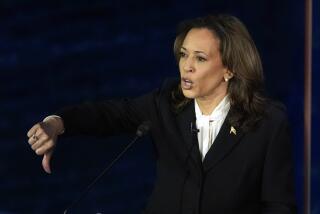Poles Rush to Sell Off Dollars for <i> Zloties</i>
- Share via
WARSAW — A crash in the value of the dollar against the Polish zloty has caused havoc in Warsaw’s free currency market and people are doing what once seemed unthinkable--they are selling dollars for zloties in droves.
On what the press has dubbed “Black Tuesday” this week, the tumbling free-market value of the dollar hit about 5,000 zloties , compared to about 12,000 when the Solidarity-led government took over from the Communists on Sept. 12.
In a country where the local currency is so weak that people can buy most big items such as cars and houses only with hard currency, most Poles usually want to buy dollars.
But on Tuesday, as has been the case increasingly in recent weeks, people bucked the trend by selling big sums of dollars in the hope that the dollar’s fall would continue and they could resell their zloties at a profit.
Others rushed to the bank to draw dollars for another reason--they suddenly discovered that some goods had become cheaper in special hard currency shops than in ordinary stores. For instance, a kilo, or 2.2 pounds, of bananas sold for $1.20 in a hard-currency store Wednesday, while in an ordinary shop a street away, it sold for about $2.
“All theories are going to pieces. Even those who kept dollars in bank accounts have decided to draw them, as alcohol or radios and televisions cost much less in Pewex or Baltona (hard currency) stores than for zloties ,” the government newspaper Rzeczpospolita said Wednesday.
“But there is a large group, perhaps the majority, who have drawn hard currency from accounts in order to exchange it promptly for zloties and, when the rate drops further, buy dollars and make money from the dollar slump,” it said.
Even the economists are confused. Some say annual inflation of close to 300% has forced people to sell dollars because the real value of wages has fallen and they are short of zloties.
Others suggest that Poles are less afraid now than they were a few months ago that political and economic reform will create chaos in the economy, and they feel less need to protect themselves against zloty inflation by hoarding hard currency.
The government has been steadily devaluing the zloty to narrow the vast gap between its official and free-market rates against the dollar. It wants the rates to merge so that the zloty can become convertible on the domestic market.
The official rate is for tourists and trade. A free market has thrived since Poles were allowed to set up private foreign exchange booths last spring with rates set by market forces.
The National Bank devalued the zloty’s official rate by 14.3% to 2,800 zloties per dollar Monday. The next day, the dollar’s free-market rate fell from about 6,000 to about 5,000 zloties.
Currency dealers said the dollar held steady in Warsaw on Wednesday, but the fall was being felt in the provinces.
In other markets around the world, the dollar was firm against other hard currencies.
“This is still a puzzle for economists,” deputy government spokesman Henryk Wozniakowski said at a news conference. “Our economists think the dollar rate may have reached the lowest possible point and that it will possibly rise again.”
More to Read
Sign up for Essential California
The most important California stories and recommendations in your inbox every morning.
You may occasionally receive promotional content from the Los Angeles Times.













